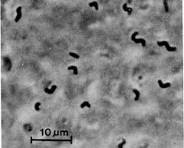Azospirillum
The morphology of Azospirillum is distinct and adapted for
its role as a nitrogen-fixing bacterium, primarily associated with the roots of
grasses and other plants. Here are its key morphological characteristics:
1. Shape
- Spiral or Curved
Rods: Azospirillum is typically spiral-shaped or curved rod-shaped (vibrioid),
with cells ranging from 1–2 micrometers in diameter and 2–3 micrometers in
length.
- Pleomorphic: The
bacterium can exhibit variations in shape under different growth conditions,
appearing as either straight rods or more curved forms.
2. Cell Structure
- Gram-Negative: Azospirillum
has a gram-negative cell wall, characterized by a thin peptidoglycan layer
surrounded by an outer membrane rich in lipopolysaccharides.
- Capsule
Formation: Some strains produce a slimy, polysaccharide-based capsule around
their cells, which aids in root attachment and protection.
3. Motility
- Highly Motile: Azospirillum
is motile, possessing one or more polar flagella. This flagellar arrangement
enables it to move actively toward plant roots and colonize the rhizosphere.
- Chemotaxis: The
bacterium exhibits chemotaxis, moving in response to plant root exudates (e.g.,
sugars, amino acids) that attract it toward the roots.
4. Colony Morphology
(on Agar)
- On solid media, Azospirillum
forms:
- Creamy or
Pinkish Colonies: Depending on the species, colonies can appear creamy white or
slightly pink.
- Mucoid Texture:
Colonies often have a mucoid, slimy texture due to the production of
extracellular polysaccharides.
5. Cell Arrangement
- Single Cells or
Short Chains: Azospirillum typically exists as single cells but can also form
short chains, especially under nutrient-rich conditions.
6. Intracellular
Inclusions
- Poly-β-Hydroxybutyrate
(PHB) Granules: Cells often contain PHB granules, which act as energy and
carbon reserves, particularly under nutrient-limited conditions.
- Gas Vesicles: In
some strains, gas vesicles are present, which help regulate buoyancy in liquid
environments, allowing the bacterium to position itself optimally for nutrient
uptake.
7. Adaptation for
Root Colonization
- Attachment
Structures: Azospirillum can form attachment structures like fibrils or
fimbriae that help it adhere to plant roots, facilitating colonization of the
rhizosphere.
- Biofilm
Formation: It can produce biofilms on plant roots, enhancing its symbiotic
association with host plants.
8. Size
- Azospirillum
cells are relatively small compared to other soil bacteria, with dimensions
generally around 0.7–1.0 micrometers in diameter and 1.0–3.0 micrometers in
length.
9. Habitat Preference
- It is primarily
found in the rhizosphere of grasses, cereals, and other plants. Its curved
shape and motility help it navigate the complex root microenvironment and
effectively fix nitrogen.
The morphology of Azospirillum enables it to thrive in the
rhizosphere, providing a symbiotic relationship with plants by fixing nitrogen,
improving nutrient uptake, and promoting plant growth.
To produce Azospirillum bacteria in compost, the feedstock
materials should provide suitable nutrients and conditions that encourage its
growth and nitrogen-fixing ability. Here are the essential materials:
1. Grass or Cereal
Residues
- Examples: Grass
clippings, straw, rice husks, maize stalks, or wheat straw.
- Purpose: Azospirillum
is naturally found in association with grasses and cereals, making these
residues ideal feedstock. They provide familiar organic material and root-like
compounds that enhance colonization.
2. Sugar-Rich
Materials
- Examples:
Molasses, sugarcane bagasse, or fruit peels.
- Purpose: Simple
sugars act as an immediate carbon source, boosting Azospirillum growth.
Molasses is especially effective due to its high sugar content, promoting rapid
bacterial multiplication.
3. Nitrogen-Rich
Organic Matter
- Examples: Green
manure, fresh cow dung, legume residues, or poultry manure.
- Purpose: While Azospirillum
is a nitrogen fixer, the presence of additional nitrogen sources supports
faster initial growth and biomass production.
4. Phosphorus Sources
- Examples: Rock
phosphate, bone meal, or guano.
- Purpose: Azospirillum
requires phosphorus for efficient nitrogen fixation and cellular functions.
Adding rock phosphate or bone meal helps ensure sufficient phosphorus
availability.
5. Biochar or
Charcoal
- Purpose: Biochar
serves as a habitat for Azospirillum, enhancing its colonization by providing a
stable, porous surface that retains moisture and nutrients.
6. Humic Acid or
Compost Tea
- Purpose: Humic
acid or compost tea stimulates microbial growth and enhances nutrient
availability. They support the growth and colonization of Azospirillum by
improving the compost's overall nutrient profile.
7. Neutral pH
Adjusters
- Examples: Wood
ash, lime, or crushed eggshells.
- Purpose: Azospirillum
thrives best at a slightly acidic to neutral pH (6.5–7.5). Adding pH-adjusting
materials helps create optimal growth conditions.
8. Fresh Soil
Inoculant
- Example: Soil
from the rhizosphere of grasses, cereals, or legumes.
- Purpose: Adding a
small amount of soil that already contains Azospirillum introduces native
strains into the compost, accelerating colonization and growth.
9. Legume Plant
Residues
- Examples:
Residues from beans, peas, lentils, or clover.
- Purpose:
Leguminous residues often create a favorable environment for nitrogen-fixing
bacteria, boosting Azospirillum populations by providing organic carbon and
nitrogen sources.
10. Rice Bran or
Wheat Bran
- Purpose: Brans
are nutrient-rich and provide additional carbon and minerals, supporting the
growth of Azospirillum in the compost.
By incorporating these feedstock materials into the compost,
you can create an environment that supports the proliferation of Azospirillum.
It is crucial to maintain adequate moisture, aeration, and temperature to
facilitate optimal bacterial growth and activity in the compost.





Comments
Post a Comment